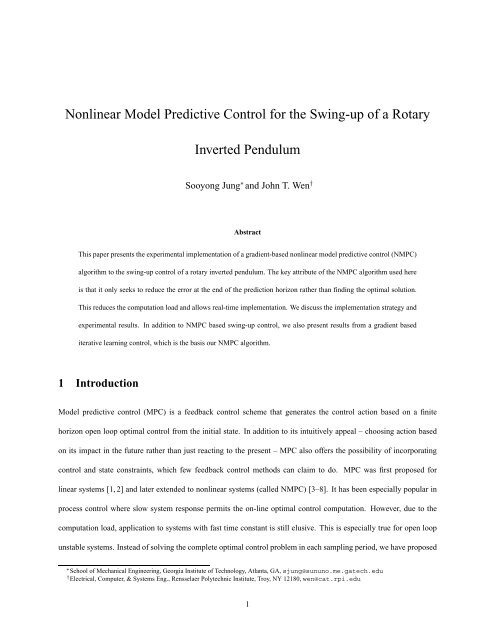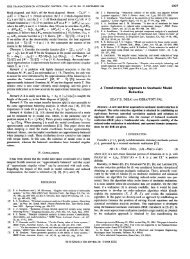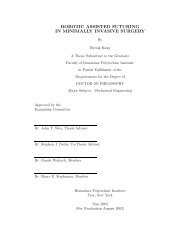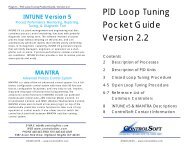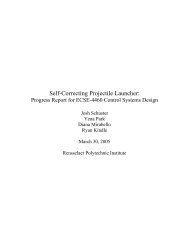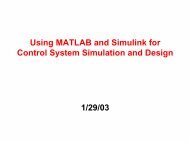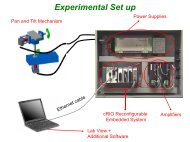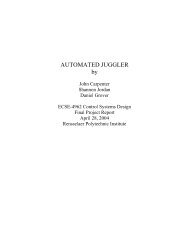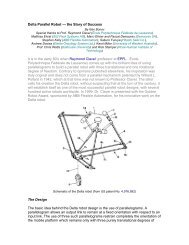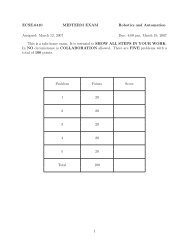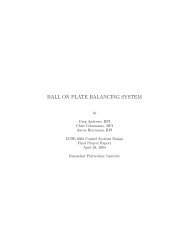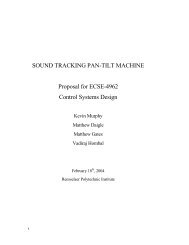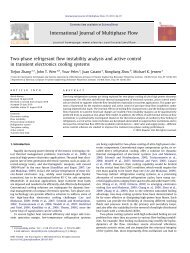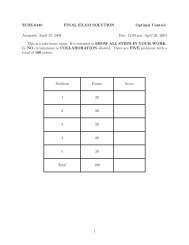Nonlinear Model Predictive Control for the Swing-up of a Rotary ...
Nonlinear Model Predictive Control for the Swing-up of a Rotary ...
Nonlinear Model Predictive Control for the Swing-up of a Rotary ...
Create successful ePaper yourself
Turn your PDF publications into a flip-book with our unique Google optimized e-Paper software.
<strong>Nonlinear</strong> <strong>Model</strong> <strong>Predictive</strong> <strong>Control</strong> <strong>for</strong> <strong>the</strong> <strong>Swing</strong>-<strong>up</strong> <strong>of</strong> a <strong>Rotary</strong><br />
Inverted Pendulum<br />
Sooyong Jung ∗ and John T. Wen †<br />
Abstract<br />
This paper presents <strong>the</strong> experimental implementation <strong>of</strong> a gradient-based nonlinear model predictive control (NMPC)<br />
algorithm to <strong>the</strong> swing-<strong>up</strong> control <strong>of</strong> a rotary inverted pendulum. The key attribute <strong>of</strong> <strong>the</strong> NMPC algorithm used here<br />
is that it only seeks to reduce <strong>the</strong> error at <strong>the</strong> end <strong>of</strong> <strong>the</strong> prediction horizon ra<strong>the</strong>r than finding <strong>the</strong> optimal solution.<br />
This reduces <strong>the</strong> computation load and allows real-time implementation. We discuss <strong>the</strong> implementation strategy and<br />
experimental results. In addition to NMPC based swing-<strong>up</strong> control, we also present results from a gradient based<br />
iterative learning control, which is <strong>the</strong> basis our NMPC algorithm.<br />
1 Introduction<br />
<strong>Model</strong> predictive control (MPC) is a feedback control scheme that generates <strong>the</strong> control action based on a finite<br />
horizon open loop optimal control from <strong>the</strong> initial state. In addition to its intuitively appeal – choosing action based<br />
on its impact in <strong>the</strong> future ra<strong>the</strong>r than just reacting to <strong>the</strong> present – MPC also <strong>of</strong>fers <strong>the</strong> possibility <strong>of</strong> incorporating<br />
control and state constraints, which few feedback control methods can claim to do. MPC was first proposed <strong>for</strong><br />
linear systems [1, 2] and later extended to nonlinear systems (called NMPC) [3–8]. It has been especially popular in<br />
process control where slow system response permits <strong>the</strong> on-line optimal control computation. However, due to <strong>the</strong><br />
computation load, application to systems with fast time constant is still elusive. This is especially true <strong>for</strong> open loop<br />
unstable systems. Instead <strong>of</strong> solving <strong>the</strong> complete optimal control problem in each sampling period, we have proposed<br />
∗ School <strong>of</strong> Mechanical Engineering, Georgia Institute <strong>of</strong> Technology, Atlanta, GA, sjung@sununo.me.gatech.edu<br />
† Electrical, Computer, & Systems Eng., Rensselaer Polytechnic Institute, Troy, NY 12180, wen@cat.rpi.edu<br />
1
an NMPC scheme [9] that only seeks to reduce <strong>the</strong> predicted state error. The reduced computation load points to <strong>the</strong><br />
potential applicability to systems with fast dynamics. Simulation results thus far have been promising. In this paper,<br />
we present <strong>the</strong> first experimental results <strong>of</strong> this NMPC scheme, applied to <strong>the</strong> swing-<strong>up</strong> <strong>of</strong> a rotary inverted pendulum.<br />
Be<strong>for</strong>e implementing our NMPC scheme, we first test on <strong>the</strong> experiment an iterative learning control that is based<br />
on <strong>the</strong> same gradient iteration approach [10]. An fixed horizon open loop control is refined in each run by using <strong>the</strong><br />
measured error from <strong>the</strong> physical experiment in <strong>the</strong> previous run and <strong>the</strong> gradient matrix from an analytical model.<br />
The swing-<strong>up</strong> and balancing (using a linear controller) is consistently achieved after only a few iterations.<br />
For <strong>the</strong> NMPC implementation, <strong>the</strong> analytical model is used to refine <strong>the</strong> control sequence in each iteration. From<br />
<strong>the</strong> open loop control experiment, a significant mismatch between <strong>the</strong> model and experiment is observed. However,<br />
by tuning <strong>the</strong> design parameters, including <strong>the</strong> sampling rate, prediction horizon, control penalty function, and <strong>up</strong>date<br />
parameter, we are able to achieve consistent swing-<strong>up</strong> experimentally. For <strong>the</strong> real-time implementation, we have used<br />
MATLAB xPC Target as <strong>the</strong> real-time computation plat<strong>for</strong>m. For <strong>the</strong> rotary inverted pendulum (which has 4 states)<br />
we are able to achieve 5ms sampling time <strong>for</strong> an 80-step look-ahead horizon.<br />
The rest <strong>of</strong> <strong>the</strong> paper is organized as follows: The iterative learning control is discussed in Section 2. The NMPC<br />
control is presented in Section 3. The real-time computation plat<strong>for</strong>m is discussed in Section 4. The experimental<br />
results are shown in Section 5.<br />
2 Iterative Learning <strong>Swing</strong>-<strong>up</strong> <strong>Control</strong><br />
An open loop control strategy was proposed in [10] <strong>for</strong> <strong>the</strong> path planning <strong>of</strong> nonholonomic systems. This strategy<br />
has served as <strong>the</strong> basis <strong>for</strong> <strong>the</strong> later extension to NMPC implementation [9]. Since this strategy is gradient based, <strong>the</strong><br />
complete model in<strong>for</strong>mation is needed. When this open loop control is applied experimentally, large error results due<br />
to <strong>the</strong> modeling error. In this section, we describes an extension to <strong>the</strong> iterative learning framework by using <strong>the</strong> end<br />
point error obtained experimentally to <strong>up</strong>date <strong>the</strong> open control using <strong>the</strong> assumed model.<br />
2
2.1 Open Loop <strong>Control</strong><br />
We first briefly review <strong>the</strong> gradient based control law used in [10]. Consider a discrete nonlinear system (obtained<br />
through, <strong>for</strong> example, finite difference approximation <strong>of</strong> a continuous time system)<br />
where xk ∈Rn and uk ∈Rm <br />
. The goal is to find u =<br />
xk+1 = f(xk)+g(xk)uk<br />
u T 0 u T 1 ... u T M−1<br />
T<br />
(1)<br />
to drive xk from a given initial<br />
state x0 to a given final state xd. We use φM (x0, u) to denote <strong>the</strong> state xM obtained by using <strong>the</strong> control u, starting<br />
from <strong>the</strong> initial state x0.<br />
We will approximate <strong>the</strong> control trajectory u by using <strong>the</strong> basis functions {ψni : i =1,...,N,n=1,...,N}:<br />
<br />
where Ψk =<br />
ψ1k ... ψNk<br />
<br />
where Ψ= ΨT 0 ... ΨT M−1<br />
<br />
and λ =<br />
T<br />
.<br />
uk =<br />
N<br />
n=1<br />
λ1 ... λN<br />
λnψnk =Ψkλ (2)<br />
T<br />
. For <strong>the</strong> entire control trajectory, we have<br />
u =Ψλ (3)<br />
There are many possible choices <strong>of</strong> <strong>the</strong> basis functions. The standard pulse basis is not used due to <strong>the</strong> high<br />
sampling rate requirement. We have tried Fourier and Laguerre functions with <strong>the</strong> latter giving <strong>the</strong> better per<strong>for</strong>mance.<br />
This is due in part to <strong>the</strong> fact that Laguerre functions decay exponentially toward <strong>the</strong> end <strong>of</strong> <strong>the</strong> horizon allowing faster<br />
control action in <strong>the</strong> beginning <strong>of</strong> <strong>the</strong> horizon and avoiding control peaking at <strong>the</strong> end <strong>of</strong> <strong>the</strong> horizon.<br />
Continuous time Laguerre functions, which <strong>for</strong>m a complete orthonormal set in L2[0, ∞), have been used in<br />
system identification [11] because <strong>of</strong> <strong>the</strong>ir convenient network realizations and exponentially decay pr<strong>of</strong>iles. The<br />
discrete time version <strong>of</strong> Laguerre functions has been used in identification <strong>for</strong> discrete time systems in [12]. Laguerre<br />
functions have also been proposed in <strong>the</strong> model predictive context [13,14]. The details <strong>of</strong> <strong>the</strong> Laguerre functions used<br />
in our implementation is described in Appendix A.<br />
3
Define <strong>the</strong> final state error as<br />
e(x0, u) =φM(x0, u) − xd. (4)<br />
The coefficients λn in (2) can be <strong>up</strong>dated using a standard gradient type <strong>of</strong> algorithm to drive e to zero. For example,<br />
<strong>the</strong> following is <strong>the</strong> Newton-Raphson <strong>up</strong>date<br />
The gradient<br />
∂φM (x0,Ψλ)<br />
∂u<br />
by u =Ψλ. Define<br />
Eq. (5) is implemented as<br />
λ (i+1) = λ (i) <br />
∂φM(x0, Ψλ<br />
− ηi<br />
(i) )<br />
Ψ<br />
∂u<br />
+<br />
e(x0, Ψλ (i) ). (5)<br />
can be obtained from <strong>the</strong> time varying linearized system <strong>of</strong> (1) about <strong>the</strong> trajectory generated<br />
L(λ) = ∂φM(x0, Ψλ)<br />
Ψ.<br />
∂u<br />
λ (i+1) = λ (i) − ηiv, L(λ (i) )v = e(x0, Ψλ (i) ) (6)<br />
where v is solved using LU decomposition. The <strong>up</strong>date parameter ηi is chosen based on <strong>the</strong> Amijo’s rule [15] (<strong>the</strong> step<br />
size continues to be halved until ei<strong>the</strong>r <strong>the</strong> prediction error, e, decreases or <strong>the</strong> minimum step size is reached). The<br />
end point error e converges to zero if L is always <strong>of</strong> full row rank. The issue <strong>of</strong> singularity (configurations at which L<br />
loses rank) has been addressed <strong>for</strong> continuous u [16, 17] and will not be addressed here.<br />
The actuator u is typically bounded: |u| ≤umax (shown here as a single input <strong>for</strong> simplicity). It can be incorpo-<br />
rated in <strong>the</strong> <strong>up</strong>date law through an exterior penalty function, e.g.,<br />
⎧<br />
0 |u| ≤umax<br />
⎪⎨<br />
h(u) =<br />
⎪⎩<br />
γ(u − umax) 2 u>umax<br />
γ(u + umax) 2 u
The <strong>up</strong>date law <strong>for</strong> λ now needs to be modified to drive (e, z) to zero:<br />
λ (i+1) = λ (i) − ηiv,<br />
where G is <strong>the</strong> gradient matrix <strong>of</strong> z with respect to λ:<br />
2.2 Iterative <strong>Control</strong> Refinement<br />
G = ∂z<br />
∂λ =<br />
M−1 <br />
i=0<br />
⎡ ⎤ ⎡ ⎤<br />
⎢<br />
⎣<br />
L ⎥ ⎢<br />
⎥<br />
⎦ v = ⎢<br />
⎣<br />
e ⎥<br />
⎦<br />
G z<br />
∂h(u)<br />
∂u<br />
<br />
<br />
<br />
u=Ψiλ<br />
(9)<br />
Ψi. (10)<br />
Due to <strong>the</strong> inevitable mismatch between <strong>the</strong> model and physical experiment, open loop control will result in possibly<br />
large end point error in <strong>the</strong> physical system. To address this issue, we have applied an iterative learning strategy which<br />
<strong>up</strong>dates <strong>the</strong> control in (9) by using <strong>the</strong> error (e, z) measured from <strong>the</strong> physical experiment but <strong>the</strong> gradient L from <strong>the</strong><br />
model. If <strong>the</strong> gradient mismatch between <strong>the</strong> physical system and <strong>the</strong> model is sufficiently small, <strong>the</strong>n <strong>the</strong> <strong>up</strong>dated<br />
control will result in a smaller end point error. The learning control scheme that we have used can be summarized as<br />
follows:<br />
1. Find <strong>the</strong> open loop swing-<strong>up</strong> control based on simulation using <strong>the</strong> analytical model (described in Appendix B).<br />
The parameters that need to be chosen are control horizon T , sampling time ts (this affects <strong>the</strong> gradient operator<br />
approximation), number <strong>of</strong> Laguerre functions N, and <strong>the</strong> decaying factor in Laguerre functions a.<br />
2. Apply <strong>the</strong> open loop control trajectory to <strong>the</strong> physical system and save <strong>the</strong> resulting state trajectory.<br />
3. Update <strong>the</strong> control by using <strong>the</strong> actual final state error. The gradient matrix is computed by linearizing <strong>the</strong><br />
analytical model along <strong>the</strong> measured state trajectory and <strong>the</strong> applied control trajectory.<br />
4. Iterate steps 2 and 3 until <strong>the</strong> end point error e is sufficiently small.<br />
For <strong>the</strong> practical implementation <strong>of</strong> this learning algorithm, <strong>the</strong>re are a number <strong>of</strong> parameters that need to chosen;<br />
<strong>the</strong> key ones are:<br />
1. Number <strong>of</strong> Basis Function, N. Large N means better approximation <strong>of</strong> u but it also increases <strong>the</strong> computation<br />
load (this becomes more important <strong>for</strong> NMPC).<br />
5
2. Length <strong>of</strong> Horizon, M. M needs to be sufficiently large so that <strong>the</strong> end point can be reached with <strong>the</strong> specified<br />
bound on u.<br />
3. Decaying Factor in Laguerre Functions, a. This parameter (between 0 and 1) determines <strong>the</strong> decay rate <strong>of</strong> ψn.<br />
Smaller <strong>the</strong> a, faster is <strong>the</strong> convergence <strong>of</strong> u to zero. However, if a is chosen too small, <strong>the</strong> control constraint<br />
may be difficult to satisfy.<br />
The experimental results are given in Section 5.1.<br />
3 <strong>Nonlinear</strong> <strong>Model</strong> <strong>Predictive</strong> <strong>Control</strong> (NMPC)<br />
This section presents <strong>the</strong> NMPC algorithm that we have implemented <strong>for</strong> <strong>the</strong> pendulum swing-<strong>up</strong> experiment. The<br />
algorithm is based on <strong>the</strong> result in [9]. The basic idea is simple: <strong>the</strong> open loop control law iteration is executed with<br />
<strong>the</strong> current state as <strong>the</strong> initial state and <strong>the</strong> current control trajectory as <strong>the</strong> initial guess <strong>of</strong> <strong>the</strong> control. Then a fixed<br />
number <strong>of</strong> Newton-steps is taken and <strong>the</strong> resulting control is applied. The process <strong>the</strong>n repeats at <strong>the</strong> next sampling<br />
time.<br />
3.1 Description <strong>of</strong> <strong>the</strong> NMPC Algorithm<br />
For <strong>the</strong> NMPC implementation, due to <strong>the</strong> moving horizon implementation, we use <strong>the</strong> pulse basis <strong>for</strong> discretization.<br />
To describe <strong>the</strong> algorithm analytically, again consider <strong>the</strong> discrete nonlinear system (1). Let <strong>the</strong> prediction horizon be<br />
M. Denote <strong>the</strong> predictive control vector at time k by u k,M :<br />
uk,M =[u (k)<br />
1 , ...., u(k)<br />
M ], uk,M ∈ Rm·M . (11)<br />
Let φM(xk, u k,M ) be <strong>the</strong> state at <strong>the</strong> end <strong>of</strong> <strong>the</strong> prediction horizon, starting from xk and using <strong>the</strong> control vector u k,M .<br />
The predicted state error is <strong>the</strong>n<br />
eM,k = φM(xk, u k,M ) − xd. (12)<br />
The main idea <strong>of</strong> <strong>the</strong> algorithm is to simultaneously per<strong>for</strong>m <strong>the</strong> open loop iteration over <strong>the</strong> prediction horizon and<br />
apply <strong>the</strong> <strong>up</strong>dated control to <strong>the</strong> system at <strong>the</strong> same time. The implementation <strong>of</strong> <strong>the</strong> algorithm can be summarized as<br />
6
follows:<br />
1. At <strong>the</strong> initial time with <strong>the</strong> given initial state x0, choose <strong>the</strong> initial guess <strong>of</strong> <strong>the</strong> predictive control vector u 0,M.<br />
Also compute <strong>the</strong> equilibrium control, ud from<br />
2. For k ≥ 0,<br />
(a) Calculate one Newton-step control <strong>up</strong>date:<br />
f(xd)+g(xd)ud = xd<br />
(13)<br />
v k,M = u k,M − ηk(∇u k,M φM(xk, u k,M )) † eM,k. (14)<br />
The gain, ηk, is found based on Amijo’s rule to ensure predicted error is strictly decreasing. This can be<br />
done as long as <strong>the</strong> gradient matrix is non-singular.<br />
(b) Shift <strong>the</strong> predictive control vector by 1 step (since <strong>the</strong> first element will be used <strong>for</strong> <strong>the</strong> actual control) and<br />
add <strong>the</strong> equilibrium control at <strong>the</strong> end <strong>of</strong> <strong>the</strong> vector:<br />
u k+1,M =Γv k,M +Φud<br />
where Γ ∈ R mM×mM and Φ ∈ R mM×m are defined as<br />
⎡<br />
⎢<br />
Γ= ⎢<br />
⎣<br />
0 m(M−1)×m<br />
0m×m<br />
(c) Compute <strong>the</strong> control, u(k) to be applied as<br />
where Λ=[Im 0 m×(M−1)m].<br />
(d) Repeat Step 2a–2c at <strong>the</strong> next time instant.<br />
I m(M−1)<br />
0 m×m(M−1)<br />
u(k) =Λv k,M<br />
7<br />
⎤ ⎡<br />
⎥ ⎢<br />
⎥<br />
⎦ , Φ= ⎢<br />
⎣<br />
0 m(M−1)×m<br />
Im<br />
⎤<br />
⎥<br />
⎦<br />
(15)<br />
(16)
Note that <strong>for</strong> stability, <strong>the</strong> non-singularity condition <strong>of</strong> <strong>the</strong> gradient matrix is needed as in <strong>the</strong> open-loop case. For a<br />
more detailed discussion <strong>of</strong> <strong>the</strong> stability condition, see [18].<br />
Remarks:<br />
1. The state and control constraint can be incorporated through exterior penalty functions as in (8).<br />
2. The parameters that affect <strong>the</strong> per<strong>for</strong>mance <strong>of</strong> this algorithm are:<br />
• Prediction horizon M: This is determined from T/ts where T is <strong>the</strong> horizon in time and ts is <strong>the</strong> sampling<br />
rate. Large T is beneficial in keeping u within <strong>the</strong> constraint but implies heavier computation load in real-<br />
time. Small ts is important to keep <strong>the</strong> approximation error (due to discretization) small, but it also leads<br />
to large M and heavier real-time computation load.<br />
• Initial predictive control vector, u 0,M : Without any a priori insight, this can just be chosen as a zero vector.<br />
If some <strong>of</strong>f-line optimization has already been per<strong>for</strong>med, it can be used as <strong>the</strong> initial guess.<br />
4 Real-Time Implementation<br />
The learning control and NMPC algorithms have been applied to a rotary inverted pendulum testbed. The system<br />
is nonlinear, underactuated, and unstable at <strong>the</strong> target state (vertical <strong>up</strong> position), making <strong>the</strong> system a challenging<br />
candidate <strong>for</strong> control. The horizontal link is controlled to bring <strong>the</strong> vertical link <strong>up</strong>right. This is called <strong>the</strong> swing-<strong>up</strong><br />
control. The system model is included in Appendix B. In this section, we describe <strong>the</strong> physical hardware and s<strong>of</strong>tware<br />
environment that we have used to implement <strong>the</strong> learning and NMPC algorithms.<br />
4.1 Hardware<br />
The experiment was constructed as part <strong>of</strong> a kit in s<strong>up</strong>port <strong>of</strong> control education [19]. A MicroMo motor is used in<br />
<strong>the</strong> driving joint. A 1024-count encoder is mounted on each joint. The open-loop control law is implemented on<br />
a DSP control board made by ARCS, Inc. This board includes a TI C30 class processor and on-board A/D, D/A,<br />
encoder, and digital I/O interfaces. The feedback NMPC control is implemented using MATLAB xPC Target with<br />
Real-Time Workshop and Simulink Toolbox from MathWorks, Inc. The incremental encoder board is APCI-1710<br />
from ADD-DATA, Inc., s<strong>up</strong>porting 4 channels <strong>of</strong> single-ended/differential encoder with 32-bit resolution. The D/A<br />
8
oard is PCIM-DAS1602/16 from Measurement Computing, Corp., which s<strong>up</strong>ports 2 16-bit D/A channels. The real-<br />
time controlling PC is an AMD Athlon 1.4GHz with 512MB RAM.<br />
4.2 S<strong>of</strong>tware<br />
4.2.1 Simulation <strong>Model</strong><br />
Both learning control and NMPC have been extensively tested on <strong>the</strong> simulation model be<strong>for</strong>e applying to <strong>the</strong> physical<br />
experiment. Simulink is used <strong>for</strong> <strong>the</strong> simulation study as well as <strong>for</strong> <strong>the</strong> real-time code generation by using <strong>the</strong> Real-<br />
Time Workshop. In <strong>the</strong> Simulink model, <strong>the</strong> NMPC algorithm was programmed in C and converted into a Simulink<br />
S-Function block by using <strong>the</strong> C-MEX S-Function Wrapper. This simulation environment allows us to tune <strong>the</strong><br />
controller parameters.<br />
4.2.2 Real-Time <strong>Model</strong><br />
For <strong>the</strong> iterative learning control, an open-loop controller is coded using Simulink and compiled into C-code by using<br />
<strong>the</strong> Real-Time Workshop (RTW). The state variables are logged <strong>for</strong> each run <strong>for</strong> <strong>the</strong> <strong>of</strong>f-line control <strong>up</strong>date. The<br />
NMPC algorithm is also coded using Simulink and compiled using RTW.<br />
4.2.3 Velocity Estimation<br />
For <strong>the</strong> physical experiment, only <strong>the</strong> position variable is available (from <strong>the</strong> incremental encoders), and velocities<br />
have to be estimated from <strong>the</strong> position measurement. For <strong>the</strong> open-loop control, velocities are estimated by simple<br />
Euler approximation. For <strong>the</strong> NMPC control system, <strong>the</strong> washout filter is used. When <strong>the</strong> pendulum is near <strong>the</strong><br />
vertical equilibrium, a full order linear observer is used. A more detailed study <strong>of</strong> <strong>the</strong> effect <strong>of</strong> velocity estimation on<br />
<strong>the</strong> per<strong>for</strong>mance <strong>of</strong> NMPC can be found in [20].<br />
9
5 Experimental Results<br />
5.1 Iterative Learning <strong>Control</strong><br />
Since <strong>for</strong> <strong>the</strong> learning control, <strong>the</strong> input is open-loop, real-time computation load is not an issue. Hence we choose a<br />
longer prediction horizon:<br />
T =1.5s, ts =5ms, M = T/ts = 300.<br />
The number <strong>of</strong> Laguerre functions used is N =10and <strong>the</strong> Laguerre decaying factor, a, is chosen to be 0.9. For <strong>the</strong><br />
control penalty function, we choose<br />
γ =0.45 umax =0.45N-m umin = −0.45N-m<br />
We have observed that <strong>the</strong>se parameters may vary significantly and still achieve swing-<strong>up</strong> and capture. The key<br />
consideration is that ts should be chosen small enough to ensure sufficiently small discretization error and T should<br />
be chosen large enough to allow swing-<strong>up</strong> with <strong>the</strong> specified control bound. Though <strong>the</strong> analytical model is not good<br />
enough <strong>for</strong> direct open loop control, it appears to be adequate <strong>for</strong> generating a descent direction.<br />
For <strong>the</strong> physical experiment, <strong>the</strong> initial control sequence is obtained using <strong>the</strong> algorithm described in Section 2.1.<br />
However, <strong>the</strong> model/plant mismatch prevents <strong>the</strong> pendulum to be captured by <strong>the</strong> linear controller. After three iter-<br />
ations using <strong>the</strong> gradient algorithm in Section 2.2, <strong>the</strong> linear controller is able to capture and balance <strong>the</strong> pendulum.<br />
Figure 1 shows <strong>the</strong> experimental results using <strong>the</strong> control sequence obtained after <strong>the</strong> third iteration. The pendulum<br />
link is shown to be swung <strong>up</strong> (i.e., x2 goes from −90 ◦ to 90 ◦ ) after two swings, and <strong>the</strong>n captured and balanced by<br />
<strong>the</strong> linear controller. Note that <strong>the</strong> control ef<strong>for</strong>t is well within <strong>the</strong> saturation limit.<br />
5.2 NMPC<br />
After tuning <strong>the</strong> controller parameters using simulation, we have settled with <strong>the</strong> choice <strong>of</strong><br />
M =80, T =0.4s, ts =5ms.<br />
10
Again, <strong>the</strong>se parameters may be adjusted and still achieve consistent swing-<strong>up</strong>. The parameter guide line is similar to<br />
<strong>the</strong> iterative learning control case, ts should be small enough to limit <strong>the</strong> discretization error, T should be large enough<br />
<strong>for</strong> <strong>the</strong> control bound to be satisfied. We have observed consistent swing-<strong>up</strong> and capture <strong>for</strong> T varying between<br />
0.3 sec. and 0.45 sec., and ts varying between 4 ms and 6 ms. The number <strong>of</strong> swings (and hence <strong>the</strong> time to reach <strong>the</strong><br />
swing-<strong>up</strong> position) does vary with <strong>the</strong> choice <strong>of</strong> <strong>the</strong>se parameters. The initial control vector is set to zero to minimize<br />
<strong>the</strong> use <strong>of</strong> a priori in<strong>for</strong>mation. The control constraint is imposed via a quadratic exterior penalty function described<br />
in (7), with <strong>the</strong> parameters<br />
γ =0.45, umax =0.1N-m, umin = −0.1N-m.<br />
Note that <strong>the</strong> exterior penalty function does not ensure a hard bound on <strong>the</strong> input; <strong>the</strong>re<strong>for</strong>e, a tighter control constraint<br />
is chosen to satisfy <strong>the</strong> physical constraint <strong>of</strong> 0.45N-m. In both simulation and physical experiments, a hard saturation<br />
constraint <strong>of</strong> ±0.45N-m is imposed <strong>for</strong> <strong>the</strong> control input.<br />
The simulation result using <strong>the</strong> analytical model is shown in Figure 2. Note that <strong>the</strong> pendulum link initially moves<br />
in <strong>the</strong> opposite direction as <strong>the</strong> iterative control result in Figure 1, since <strong>the</strong> initial control sequence is chosen to be<br />
zero and it takes time <strong>for</strong> <strong>the</strong> control sequence to evolve through gradient modification in (15). After about 0.3 sec.,<br />
<strong>the</strong> control and state trajectories become more similar to <strong>the</strong> open loop result in Figure 1. Four sample experimental<br />
runs using <strong>the</strong> same controller parameters are shown in Figures 3-6. Even though <strong>the</strong> controller parameters are <strong>the</strong><br />
same, <strong>the</strong> response behaves differently after <strong>the</strong> pendulum is swung <strong>up</strong>. This is due to <strong>the</strong> lack <strong>of</strong> robustness in <strong>the</strong><br />
balanced configuration. In Figure 3-4, <strong>the</strong> pendulum remains balanced after swing-<strong>up</strong>, but in Figure 5-6, <strong>the</strong> pendulum<br />
falls down at about 3 sec., in different directions, and <strong>the</strong>n swings <strong>up</strong> again within 1 sec.<br />
In all <strong>the</strong>se experiments, <strong>the</strong> state trajectories in <strong>the</strong> swing-<strong>up</strong> phase match reasonably well with <strong>the</strong> simulation<br />
prediction shown in Figure 7. The control trajectories show <strong>the</strong> same trend within <strong>the</strong> first second, but <strong>the</strong> experimental<br />
responses contain much more chattering between <strong>the</strong> saturation levels when it is near <strong>the</strong> swung-<strong>up</strong> position (see<br />
Figure 8). In general, <strong>the</strong> NMPC controller is very sensitive to disturbance during <strong>the</strong> balancing phase. It appears that<br />
<strong>the</strong> 80-step horizon is too long at <strong>the</strong> balanced position <strong>for</strong> <strong>the</strong> controller to react effectively to <strong>the</strong> destabilizing effect<br />
<strong>of</strong> <strong>the</strong> gravity. We have recently tried to adjust <strong>the</strong> length <strong>of</strong> <strong>the</strong> prediction horizon near <strong>the</strong> balancing position and had<br />
some success [20]. This inability to maintain <strong>the</strong> balancing position may be attributed to several factors: modeling<br />
error due to <strong>the</strong> vibration <strong>of</strong> <strong>the</strong> fixed s<strong>up</strong>port, <strong>the</strong> relatively poor velocity estimation (estimated through washout filter<br />
11
in this implementation), and poor estimate <strong>of</strong> <strong>the</strong> Coulomb friction. When a linear observer based controller is used<br />
near <strong>the</strong> balancing state, <strong>the</strong> experimental results shown in Figure 9–10 now very close to <strong>the</strong> simulation.<br />
6 Conclusions<br />
This paper presents <strong>the</strong> experimental implementation and results <strong>of</strong> iterative learning control and nonlinear model<br />
predictive control applied to <strong>the</strong> swing-<strong>up</strong> <strong>of</strong> a rotary inverted pendulum with input torque constraint. In both cases,<br />
computation load is reduced by using a Newton-step control <strong>up</strong>date instead <strong>of</strong> solving <strong>the</strong> complete optimal control<br />
problem. In <strong>the</strong> real-time control case with NMPC, MATLAB xPC-Target is used as <strong>the</strong> real-time computation plat-<br />
<strong>for</strong>m, and 5ms sampling rate is achieved with an 80-step look-ahead horizon. Co<strong>up</strong>led with a linear control law that<br />
captures and balances <strong>the</strong> pendulum in <strong>the</strong> neighborhood <strong>of</strong> <strong>the</strong> vertical equilibrium, both iterative learning control<br />
and NMPC control can swing <strong>up</strong> and balance <strong>the</strong> <strong>the</strong> pendulum consistently. Current work involves on improving <strong>the</strong><br />
robustness <strong>of</strong> NMPC and applying NMPC to <strong>the</strong> observer implementation.<br />
Acknowledgment<br />
This work is s<strong>up</strong>ported in part by <strong>the</strong> National Science Foundations under grant CMS-9813099, and in part by <strong>the</strong><br />
Center <strong>for</strong> Advanced Technology in Automation Technologies under a block grant from <strong>the</strong> New York State Science<br />
and Technology Foundation.<br />
12
References<br />
[1] W. H. Kwon and A. E. Pearson. On feedback stabilization <strong>of</strong> time-varying discrete linear systems. IEEE Trans.<br />
on Automatic <strong>Control</strong>, 23(3):479–481, June 1978.<br />
[2] V. H. L. Cheng. A direct way to stabilize continuous-time and discrete-time linear time-varying systems. IEEE<br />
Trans. on Automatic <strong>Control</strong>, 24(4):641–643, August 1979.<br />
[3] C. C. Chen and L. Shaw. On receding horizon feedback control. Automatica, 18(3):349–352, 1982.<br />
[4] S. S. Keerthi and E. G. Gilbert. Optimal infinite-horizon feedback laws <strong>for</strong> a general class <strong>of</strong> constrained discrete-<br />
time systems : stability and moving-horizon approximation. Journal <strong>of</strong> Optimization Theory and Applications,<br />
57(2):265–293, May 1988.<br />
[5] D. Q. Mayne and H. Michalska. Receding horizon control <strong>of</strong> nonlinear system. IEEE Trans. on Automatic<br />
<strong>Control</strong>, 35(7):814–824, July 1990.<br />
[6] D. Q. Mayne and H. Michalska. Robust receding horizon control <strong>of</strong> constrained nonlinear system. IEEE Trans.<br />
on Automatic <strong>Control</strong>, 38(11):1623–1633, November 1993.<br />
[7] A. Jadbabaie, J. Yu, and J. Hauser. Receding horizon control <strong>of</strong> <strong>the</strong> caltech ducted fan: A control lyapunov<br />
function approach. In Proc. 1999 IEEE Conference on <strong>Control</strong> Applications, 1999.<br />
[8] S. L. Oliveira and M. Morari. Contractive model predictive control <strong>for</strong> constrained nonlinear systems. IEEE<br />
Trans. on Automatic <strong>Control</strong>, 45(6):1053–1071, June 2000.<br />
[9] F. Lizarralde, J. T. Wen, and L. Hsu. A new model predictive control strategy <strong>for</strong> affine nonlinear control systems.<br />
In Proc. 1999 American <strong>Control</strong> Conference, pages 4263–4267, San Diego, CA, June 1999.<br />
[10] A. Divelbiss and J. T. Wen. A path space approach to nonholonomic motion planning in <strong>the</strong> presence <strong>of</strong> obstacles.<br />
IEEE Trans. on Robotic and Automation, 13(3):443–451, June 1997.<br />
[11] N. Wiener. The <strong>the</strong>ory <strong>of</strong> Prediction Modern Ma<strong>the</strong>matics <strong>for</strong> Enginners. McGraw-Hill, 1956.<br />
[12] B. Wahlberg. System identification using laguerre models. IEEE Trans. on Automatic <strong>Control</strong>, 36(5):551–562,<br />
May 1991.<br />
13
[13] C. C. Zervos and G. A. Dumont. Deterministic adaptive control based on laguerre series representation. Inter-<br />
national Journal <strong>of</strong> <strong>Control</strong>, pages 2333–2359, 1988.<br />
[14] L. Wang. Discrete time model predictive control design using laguerre functions. In Proceedings <strong>of</strong> 2001<br />
American <strong>Control</strong> Conference, pages 2430–2435, Arlington, VA, 2001.<br />
[15] E. Polak. Optimization: Algorithms and Consistent Approximations. Springer-Verlag, New York, 1997.<br />
[16] E. D. Sontag. <strong>Control</strong> <strong>of</strong> systems without drift via generic loops. IEEE Trans. on Automatic <strong>Control</strong>, 40(7):1210–<br />
1219, July 1995.<br />
[17] D. Popa and J.T. Wen. Singularity computation <strong>for</strong> iterative control <strong>of</strong> nonlinear affine systems. Asian Journal<br />
<strong>of</strong> <strong>Control</strong>, 2(2):57–75, June 2000.<br />
[18] J.T. Wen and S. Jung. <strong>Nonlinear</strong> model predictive control based on <strong>the</strong> reduction <strong>of</strong> predicted state error. Tech-<br />
nical report, Rensselaer Polytechnic Institute, Troy, NY, also available at http://www.cat.rpi.edu/˜<br />
wen/papers/nmpc.pdf, July 2003.<br />
[19] B. Potsaid and J.T Wen. Edubot: a reconfigurable kit <strong>for</strong> control education. part i. mechanical design. In Proc.<br />
2000 IEEE International Conference on <strong>Control</strong> Applications, pages 50–55, 2000.<br />
[20] J. Neiling. <strong>Nonlinear</strong> model predictive control <strong>of</strong> a rotary inverted pendulum. Master’s <strong>the</strong>sis, Rensselaer Poly-<br />
technic Institute, Troy, NY., April 2003.<br />
14
A Laguerre Functions used in Learning <strong>Control</strong><br />
In continuous time, <strong>the</strong> Laguerre function set is defined as:<br />
fi(t) = e<br />
2p<br />
pt d<br />
(i − 1)!<br />
i−1<br />
dti−1 [ti−1e −2pt ] (17)<br />
where i is <strong>the</strong> order <strong>of</strong> <strong>the</strong> function set i =1, 2,...,N and p is Laguerre pole. The corresponding Laplace trans<strong>for</strong>m<br />
<strong>for</strong> this set is:<br />
Fi(s) = (s − p)i−1<br />
2p<br />
(s + p) i . (18)<br />
The z-trans<strong>for</strong>m <strong>of</strong> <strong>the</strong> discrete Laguerre function set, li(k), i=1, 2,...,N is given in [12]:<br />
Li(z) =<br />
√ 1 − a 2<br />
z − a<br />
[az − 1<br />
z − a ]i−1<br />
Based on <strong>the</strong> z-trans<strong>for</strong>m, it is possible to <strong>the</strong> discrete Laguerre function set satisfies <strong>the</strong> difference equation<br />
where<br />
with initial condition<br />
Lk =<br />
<br />
Lk+1 =ΩLk<br />
ψ1k ψ2k ... ψNk<br />
⎡<br />
⎢ a<br />
⎢ a<br />
⎢<br />
Ω= ⎢<br />
⎣<br />
0 ... 0<br />
2 − 1<br />
a(a<br />
a ... 0<br />
2 − 1) a2 a<br />
− 1 ... 0<br />
2 (a2 − 1) a(a2 ···<br />
a<br />
− 1)<br />
···<br />
... 0<br />
N−2 (a2 − 1) aN−3 (a2 ⎤<br />
− 1) ...<br />
⎥<br />
⎦<br />
a<br />
T<br />
L0 = 1 − a2 <br />
1 a a2 a3 ... aN−1 15<br />
T<br />
(19)<br />
(20)
and discrete Laguerre pole a.<br />
B <strong>Model</strong> <strong>of</strong> <strong>Rotary</strong> Inverted Pendulum<br />
The rotary inverted pendulum used in this study is shown in Figure 11. The equation <strong>of</strong> motion is <strong>of</strong> <strong>the</strong> following<br />
<strong>for</strong>m:<br />
M(θ) ¨ θ + C(θ, ˙ θ) ˙ θ + F ( ˙ θ)+G(θ) =Bu (21)<br />
where θ, ˙ θ, ¨ θ are <strong>the</strong> joint angle, velocity and acceleration vectors, M(θ) is <strong>the</strong> mass-inertia matrix, C(θ, ˙ θ) ˙ θ is <strong>the</strong><br />
centrifugal and Coriolis torques, F ( ˙ θ) is <strong>the</strong> friction, G(θ) ∈R 2 is <strong>the</strong> gravity load, and u is <strong>the</strong> applied torque.<br />
with<br />
The inertia matrix is given by<br />
m11 = m1l 2 c1 + I331<br />
⎡<br />
⎢<br />
M(θ) = ⎢<br />
⎣<br />
m11 m12<br />
m21 m22<br />
<br />
2 + m2 l1 + l2 c2 cos2 (θ2) + I222 sin2 (θ2)+I332 cos2 (θ2)+2sin(θ2)cos(θ2) I232<br />
m12 = m21 = −m2l1lc2 sin (θ2)+I122 sin (θ2)+I132 cos (θ2)<br />
m22 = m2l 2 c2 + I112<br />
C(θ, ˙ ⎡<br />
⎢<br />
θ)= ⎢<br />
⎣<br />
c11 c12<br />
c21 c22<br />
with<br />
c11 = −2m2l2 c2 sin (θ2)cos(θ2) ˙ θ2 +2sin(θ2)cos(θ2)(I222 − I332 ) ˙ <br />
2<br />
θ2 +I232 4cos (θ2) − 2 θ2<br />
˙<br />
c12 = −m2l1lc2 cos (θ2) ˙ θ2 + I122 cos (θ2) ˙ θ2 − I132 sin (θ2) ˙ θ2<br />
c21 = m2l 2 c2 sin (θ2)cos(θ2) ˙ θ1 − I222 sin (θ2)cos(θ2) ˙ θ1 + I332 sin (θ2)cos(θ2) ˙ θ1 +I232<br />
c22 =0<br />
16<br />
⎤<br />
⎥<br />
⎦<br />
⎤<br />
⎥<br />
⎦<br />
1 − 2cos 2 (θ2) ˙ θ1<br />
(22)<br />
(23)
The friction is modeled as Coloumb + viscous:<br />
F ( ˙ ⎡<br />
⎢ Fv1|<br />
θ)= ⎢<br />
⎣<br />
˙ θ1| + Fc1sgn( ˙ θ1)<br />
Fv2| ˙ θ2| + Fc2sgn( ˙ ⎤<br />
⎥<br />
⎦<br />
θ2)<br />
where Fv represent <strong>the</strong> coefficient <strong>of</strong> viscous friction <strong>for</strong> each joint, and Fc <strong>of</strong> Coulomb friction. For <strong>the</strong> NMPC<br />
computation, we ignore <strong>the</strong> Coulomb friction terms due to <strong>the</strong> difficulty that discontinuity poses in gradient calculation.<br />
The gravity term is<br />
The torque is applied only on <strong>the</strong> first link, <strong>the</strong>re<strong>for</strong>e<br />
⎡<br />
⎤<br />
⎢<br />
G(θ) = ⎢<br />
⎣<br />
0<br />
m2glc2 cos (θ2)<br />
⎥<br />
⎦<br />
⎡ ⎤<br />
⎢<br />
B = ⎢<br />
⎣<br />
1<br />
0<br />
⎥<br />
⎦<br />
For <strong>the</strong> state space representation, we define <strong>the</strong> state vector as<br />
⎡ ⎤<br />
⎢<br />
x = ⎢<br />
⎣<br />
θ<br />
p<br />
⎥<br />
⎦<br />
where p ∆ = M(θ) ˙ θ is <strong>the</strong> generalized momentum. The equation <strong>of</strong> motion in <strong>the</strong> state space <strong>for</strong>m is <strong>the</strong>n<br />
˙x =<br />
⎡<br />
⎢<br />
⎣<br />
M −1 (θ)p<br />
( ˙ M(θ, M−1p) − C(θ, M−1p))M −1p − F (M −1p) − G(θ)<br />
= f(x)+g(x)u.<br />
The physical parameters are determined through direct measurements:<br />
m1 =0.11409 kg l1 =0.169 m lc1 =0.1137 m<br />
m2 =0.04474 kg l2 =0.162 m lc2 =0.0511 m<br />
where subscripts 1 and 2 denote link 1 and link 2, respectively.<br />
17<br />
⎤<br />
⎥<br />
⎦ +<br />
⎡<br />
⎢<br />
⎣<br />
02×1<br />
B<br />
(24)<br />
(25)<br />
(26)<br />
⎤<br />
⎥<br />
⎦ u (27)
The moment <strong>of</strong> inertia <strong>for</strong> each link can be computed using <strong>the</strong> above values:<br />
I111 =2.62e-5 kg m2 I221 =3.59e-5 kg m2 I331 =3.43e-5 kg m2<br />
I121 = I211 =0 I131 = I311 =1.29e-5 kg m2 I231 = I321 =0<br />
I112 =1.87e-5 kg m 2 I222 =4.82e-6 kg m 2 I332 =1.86e-5 kg m 2<br />
I122<br />
= I212 =0 I132 = I312 =0 I232 = I322 =5.24e-6 kg m2<br />
Identification <strong>of</strong> friction parameters <strong>of</strong> <strong>the</strong> inverted pendulum system was per<strong>for</strong>med and are given as follows<br />
Fv1 =0.11409N-m/rad/sec Fc1 =0.008N-m<br />
Fv2 =0.0001N-m/rad/sec Fc2 =0.0N-m<br />
18
Figures<br />
states<br />
states<br />
control<br />
100<br />
0<br />
−100<br />
−200<br />
State & <strong>Control</strong> trajectories : Open−Loop System, Experiment<br />
−300<br />
0 0.5 1 1.5 2 2.5 3 3.5 4 4.5 5<br />
20<br />
10<br />
0<br />
−10<br />
−20<br />
0 0.5 1 1.5 2 2.5 3 3.5 4 4.5 5<br />
0.4<br />
0.2<br />
0<br />
−0.2<br />
−0.4<br />
0 0.5 1 1.5 2 2.5<br />
time (sec)<br />
3 3.5 4 4.5 5<br />
Figure 1: State and <strong>Control</strong> trajectories on <strong>the</strong> Open-Loop <strong>Control</strong> System: After Third Iteration<br />
19<br />
x1<br />
x2<br />
x3<br />
x4
position<br />
velocity<br />
control<br />
position<br />
200<br />
100<br />
0<br />
−100<br />
State & <strong>Control</strong> trajectories<br />
−200<br />
0 0.5 1 1.5 2 2.5 3 3.5 4 4.5 5<br />
20<br />
10<br />
0<br />
−10<br />
−20<br />
0 0.5 1 1.5 2 2.5 3 3.5 4 4.5 5<br />
0.5<br />
0<br />
−0.5<br />
0 0.5 1 1.5 2 2.5<br />
time (sec)<br />
3 3.5 4 4.5 5<br />
velocity<br />
control<br />
200<br />
100<br />
0<br />
−100<br />
Figure 2: Simulation Response with NMPC<br />
State & <strong>Control</strong> trajectories<br />
−200<br />
0 0.5 1 1.5 2 2.5 3 3.5 4 4.5 5<br />
20<br />
10<br />
0<br />
−10<br />
−20<br />
0 0.5 1 1.5 2 2.5 3 3.5 4 4.5 5<br />
0.5<br />
0<br />
−0.5<br />
0 0.5 1 1.5 2 2.5<br />
time (sec)<br />
3 3.5 4 4.5 5<br />
Figure 3: Experimental Response with NMPC: sample run #1<br />
20<br />
x<br />
1<br />
x<br />
2<br />
x<br />
3<br />
x<br />
4<br />
x<br />
1<br />
x<br />
2<br />
x<br />
3<br />
x<br />
4
position<br />
velocity<br />
control<br />
position<br />
200<br />
100<br />
0<br />
−100<br />
State & <strong>Control</strong> trajectories<br />
−200<br />
0 0.5 1 1.5 2 2.5 3 3.5 4 4.5 5<br />
20<br />
10<br />
0<br />
−10<br />
−20<br />
0 0.5 1 1.5 2 2.5 3 3.5 4 4.5 5<br />
0.5<br />
0<br />
−0.5<br />
0 0.5 1 1.5 2 2.5<br />
time (sec)<br />
3 3.5 4 4.5 5<br />
Figure 4: Experimental Response with NMPC: sample run #2<br />
velocity<br />
control<br />
200<br />
100<br />
0<br />
−100<br />
State & <strong>Control</strong> trajectories<br />
−200<br />
0 0.5 1 1.5 2 2.5 3 3.5 4 4.5 5<br />
20<br />
10<br />
0<br />
−10<br />
−20<br />
0 0.5 1 1.5 2 2.5 3 3.5 4 4.5 5<br />
0.5<br />
0<br />
−0.5<br />
0 0.5 1 1.5 2 2.5<br />
time (sec)<br />
3 3.5 4 4.5 5<br />
Figure 5: Experimental Response with NMPC: sample run #3<br />
21<br />
x<br />
1<br />
x<br />
2<br />
x<br />
3<br />
x<br />
4<br />
x<br />
1<br />
x<br />
2<br />
x<br />
3<br />
x<br />
4
x 1 (deg)<br />
80<br />
60<br />
40<br />
20<br />
0<br />
−20<br />
−40<br />
position<br />
velocity<br />
control<br />
200<br />
100<br />
0<br />
−100<br />
State & <strong>Control</strong> trajectories<br />
−200<br />
0 0.5 1 1.5 2 2.5 3 3.5 4 4.5 5<br />
20<br />
10<br />
0<br />
−10<br />
−20<br />
0 0.5 1 1.5 2 2.5 3 3.5 4 4.5 5<br />
0.5<br />
0<br />
−0.5<br />
0 0.5 1 1.5 2 2.5<br />
time (sec)<br />
3 3.5 4 4.5 5<br />
Figure 6: Experimental Response with NMPC: sample run #4<br />
State Trajectory Comparison <strong>for</strong> x(1)<br />
exp 1<br />
exp 2<br />
exp 3<br />
exp 4<br />
simulation<br />
−60<br />
0 0.2 0.4 0.6 0.8 1<br />
time (sec)<br />
1.2 1.4 1.6 1.8 2<br />
x 3 rad/sec<br />
15<br />
10<br />
5<br />
0<br />
−5<br />
State Trajectory Comparison <strong>for</strong> x(3)<br />
exp 1<br />
exp 2<br />
exp 3<br />
exp 4<br />
simulation<br />
−10<br />
0 0.2 0.4 0.6 0.8 1<br />
time (sec)<br />
1.2 1.4 1.6 1.8 2<br />
x 2 deg.<br />
150<br />
100<br />
50<br />
0<br />
−50<br />
−100<br />
State Trajectory Comparison <strong>for</strong> x(2)<br />
x<br />
1<br />
x<br />
2<br />
x<br />
3<br />
x<br />
4<br />
exp 1<br />
exp 2<br />
exp 3<br />
exp 4<br />
simulation<br />
−150<br />
0 0.2 0.4 0.6 0.8 1<br />
time (sec)<br />
1.2 1.4 1.6 1.8 2<br />
x 4 rad/sec<br />
15<br />
10<br />
5<br />
0<br />
−5<br />
−10<br />
−15<br />
State Trajectory Comparison <strong>for</strong> x(4)<br />
exp 1<br />
exp 2<br />
exp 3<br />
exp 4<br />
simulation<br />
−20<br />
0 0.2 0.4 0.6 0.8 1<br />
time (sec)<br />
1.2 1.4 1.6 1.8 2<br />
Figure 7: Comparison <strong>of</strong> State Response<br />
22
position<br />
velocity<br />
control<br />
torque (N−m)<br />
0.5<br />
0.4<br />
0.3<br />
0.2<br />
0.1<br />
0<br />
−0.1<br />
−0.2<br />
exp −0.3 1<br />
exp 2<br />
exp 3<br />
exp −0.4 4<br />
simulation<br />
200<br />
100<br />
−100<br />
<strong>Control</strong> Trajectory<br />
−0.5<br />
0 0.2 0.4 0.6 0.8 1<br />
time (sec)<br />
1.2 1.4 1.6 1.8 2<br />
0<br />
Figure 8: Comparison <strong>of</strong> <strong>Control</strong> Trajectory<br />
State & <strong>Control</strong> trajectories<br />
−200<br />
0 0.5 1 1.5 2 2.5 3 3.5 4 4.5 5<br />
20<br />
10<br />
0<br />
−10<br />
−20<br />
0 0.5 1 1.5 2 2.5 3 3.5 4 4.5 5<br />
0.5<br />
0<br />
−0.5<br />
0 0.5 1 1.5 2 2.5<br />
time (sec)<br />
3 3.5 4 4.5 5<br />
Figure 9: Experimental Response with NMPC + linear balancing control: sample run #1<br />
23<br />
x<br />
1<br />
x<br />
2<br />
x<br />
3<br />
x<br />
4
position<br />
velocity<br />
control<br />
200<br />
100<br />
0<br />
−100<br />
State & <strong>Control</strong> trajectories<br />
−200<br />
0 0.5 1 1.5 2 2.5 3 3.5 4 4.5 5<br />
20<br />
10<br />
0<br />
−10<br />
−20<br />
x<br />
3<br />
x<br />
4<br />
0 0.5 1 1.5 2 2.5 3 3.5 4 4.5 5<br />
0.5<br />
0<br />
−0.5<br />
0 0.5 1 1.5 2 2.5<br />
time (sec)<br />
3 3.5 4 4.5 5<br />
Figure 10: Experimental Response with NMPC + linear balancing control: sample run #2<br />
Figure 11: The <strong>Rotary</strong> Inverted Pendulum Experiment<br />
24<br />
x<br />
1<br />
x<br />
2


